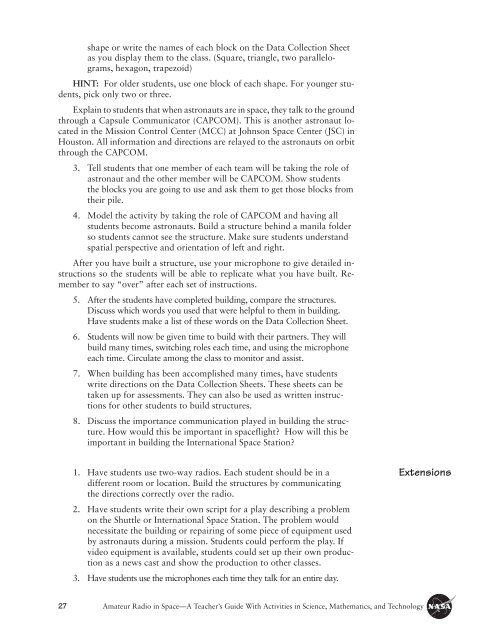Amateur Radio in Space - ER - NASA
Amateur Radio in Space - ER - NASA
Amateur Radio in Space - ER - NASA
- No tags were found...
You also want an ePaper? Increase the reach of your titles
YUMPU automatically turns print PDFs into web optimized ePapers that Google loves.
shape or write the names of each block on the Data Collection Sheetas you display them to the class. (Square, triangle, two parallelograms,hexagon, trapezoid)HINT: For older students, use one block of each shape. For younger students,pick only two or three.Expla<strong>in</strong> to students that when astronauts are <strong>in</strong> space, they talk to the groundthrough a Capsule Communicator (CAPCOM). This is another astronaut located<strong>in</strong> the Mission Control Center (MCC) at Johnson <strong>Space</strong> Center (JSC) <strong>in</strong>Houston. All <strong>in</strong>formation and directions are relayed to the astronauts on orbitthrough the CAPCOM.3. Tell students that one member of each team will be tak<strong>in</strong>g the role ofastronaut and the other member will be CAPCOM. Show studentsthe blocks you are go<strong>in</strong>g to use and ask them to get those blocks fromtheir pile.4. Model the activity by tak<strong>in</strong>g the role of CAPCOM and hav<strong>in</strong>g allstudents become astronauts. Build a structure beh<strong>in</strong>d a manila folderso students cannot see the structure. Make sure students understandspatial perspective and orientation of left and right.After you have built a structure, use your microphone to give detailed <strong>in</strong>structionsso the students will be able to replicate what you have built. Rememberto say “over” after each set of <strong>in</strong>structions.5. After the students have completed build<strong>in</strong>g, compare the structures.Discuss which words you used that were helpful to them <strong>in</strong> build<strong>in</strong>g.Have students make a list of these words on the Data Collection Sheet.6. Students will now be given time to build with their partners. They willbuild many times, switch<strong>in</strong>g roles each time, and us<strong>in</strong>g the microphoneeach time. Circulate among the class to monitor and assist.7. When build<strong>in</strong>g has been accomplished many times, have studentswrite directions on the Data Collection Sheets. These sheets can betaken up for assessments. They can also be used as written <strong>in</strong>structionsfor other students to build structures.8. Discuss the importance communication played <strong>in</strong> build<strong>in</strong>g the structure.How would this be important <strong>in</strong> spaceflight? How will this beimportant <strong>in</strong> build<strong>in</strong>g the International <strong>Space</strong> Station?1. Have students use two-way radios. Each student should be <strong>in</strong> adifferent room or location. Build the structures by communicat<strong>in</strong>gthe directions correctly over the radio.2. Have students write their own script for a play describ<strong>in</strong>g a problemon the Shuttle or International <strong>Space</strong> Station. The problem wouldnecessitate the build<strong>in</strong>g or repair<strong>in</strong>g of some piece of equipment usedby astronauts dur<strong>in</strong>g a mission. Students could perform the play. Ifvideo equipment is available, students could set up their own productionas a news cast and show the production to other classes.3. Have students use the microphones each time they talk for an entire day.Extensions27 <strong>Amateur</strong> <strong>Radio</strong> <strong>in</strong> <strong>Space</strong>—A Teacher’s Guide With Activities <strong>in</strong> Science, Mathematics, and Technology
















